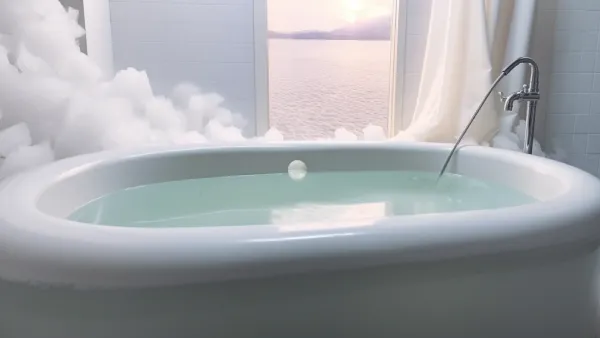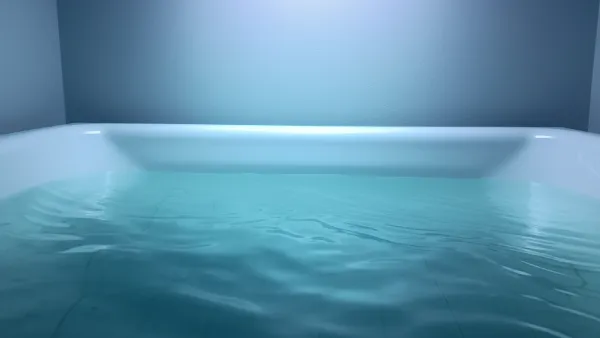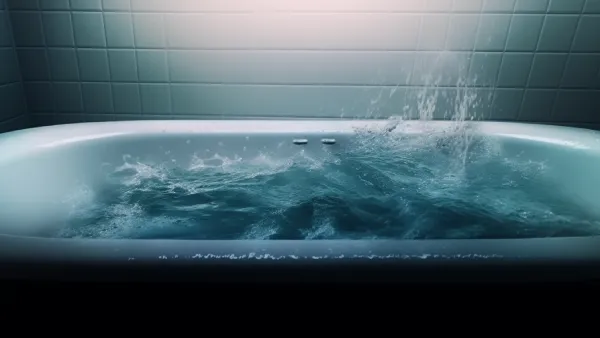Last Updated on October 17, 2023
Green water is unsettling when you’re ready for a relaxing bath. There are several possible reasons for this unusual occurrence.
Contaminated water could be the culprit, with elevated levels of copper or other pollutants imparting a greenish tint. Corroded piping is another possibility if your plumbing system features copper or galvanized steel components. Limescale buildup and copper plumbing partnerships can yield green water.
We’ll explore why the bath water is green and how to get rid of it so you can enjoy your baths without being disturbed.
Why Is My Bath Water Green: Exploring the Causes

Your bathwater might appear green due to various reasons.
- Contaminated water
- Corroded piping
- Limescale buildup
- Mold or mildew
Let’s examine each cause in detail, which will make it easier for you to resolve the green bath water issue.
Contaminated Water
When water is contaminated with elevated levels of copper, it can result in a greenish tint. This occurs because copper ions dissolve into the water, creating a reaction reflecting green hues.
Copper in your bath water may be due to copper-containing minerals in the water source. Private wells can also accumulate copper buildup over time, leading to higher contamination levels.
Corroded Piping
Corroded piping is another reason why your bath water may be green. If your plumbing system is made of copper or galvanized steel, electrolysis can occur, leading to degradation and discolored water.
Aging plumbing and corrosive or contaminated water can hasten this process and exacerbate the issue.
Limescale Buildup
If you have hard water in your area, you may notice white mineral deposits called limescale around your faucets and shower heads. The buildup of limescale in copper plumbing can result in green water if left untreated.
Limescale forms when hard water deposits minerals like calcium and magnesium on your plumbing fixtures and appliances.
It is not typically harmful to your health but can be unsightly and lead to plumbing issues if left untreated with high copper levels. You should contact the city water authority for guidance.
Mold or Mildew
The presence of mold or mildew near your plumbing can also cause green-tinted water to appear in your bathtub. These microorganisms can find their way into the water supply and pose a health risk to you and your family.
Mold and mildew thrive in dark, damp environments, making your bathroom an ideal breeding ground for these pesky organisms.
How to Get Rid of Green Bathwater?
If you’re facing the issue of green bathwater, here are the solutions to consider:
Decontaminating Your Water
You should first test your bathwater for contaminants if you have been experiencing green water.
A water testing kit can help you identify the type and levels of contaminants in your water. You should take note that copper is a common culprit behind green bathwater.
When you have well water containing high levels of copper, you will need to install a water treatment kit to reduce the copper content in your water.
But, if you are on a city water system, it’s best to consult with your city water district or the Environmental Protection Agency (EPA).
Before involving the authorities, you should ensure that your plumbing does not cause the issue.
Corroded Piping Replacement
In case you suspect that your plumbing is the cause of the green bathwater, you might need to replace the corroded or aging pipes.
To get started, identify the deteriorated pipes and measure them to purchase appropriate replacements. PEX plumbing can be a modern alternative to copper that you can consider. Before beginning any plumbing replacement work, turn off the water supply to your home.
Use a plumber’s wrench, tape, and fittings to perform the replacement. After turning the water supply on again, you should check for leaks or any signs of discolored water.
Addressing Limescale Buildup
If limescale buildup is causing your green bath water, several solutions can help address this issue.
The first step is to tackle the hard water issue that causes limescale buildup by using a water-softening kit. This solution is particularly useful in the case of well water or in cases where the source of water is hard.
Ensure that you follow the manufacturer’s instructions when using the water softener. The results might take a couple of days to become noticeable, but they are definitely worth it.
You can use natural remedies like vinegar and lemon juice for limescale deposits on surfaces like faucets. These solutions are gentle enough not to damage the surfaces but strong enough to remove the buildup.
Eliminating Mildew and Mold
You need to remove mildew and mold right away if you want to get rid of the green bath water. Mix vinegar and baking soda or use bleach to get rid of mildew and mold.
Before you start cleaning, always use appropriate safety equipment. This equipment might include gloves, goggles, and a respirator if the mold infestation is severe.
Apply the solution to the affected areas, allow it to sit, and afterward, take a brush to clean the surfaces. Different varieties of mold require different cleaning options, so tailor your approach accordingly.
Is it safe to take a bath in green water?

Bathing in water that has a green or bluish tint can be potentially harmful to your health like brown water does. This discoloration often indicates excessive levels of copper, which can adversely affect your body.
Ingesting or coming into contact with water containing high copper levels may lead to vomiting, diarrhea, nausea, and an increased risk of liver and kidney issues.
Therefore, it’s advisable to avoid using water with unusual coloration for bathing purposes and to address the underlying issue to ensure the safety and well-being of those using the water.
What is the acceptable range for copper in water?
If copper levels in the water exceed 1300 micrograms per liter, it is considered unsafe for consumption. In drinking water, the EPA has set this limit as the acceptable range for copper.
Water systems must implement treatment measures if more than 10% of tap water samples exceed the EPA’s copper action level of 1.3 milligrams per liter (mg/L). So, you have to keep copper levels in check to ensure safe and healthy drinking water.
Get Crystal Clear Bathwater With Addressing the Causes
When you see your bathwater tinged with an unexpected shade of green, it’s clear that something is amiss within your water system.
Contaminated water, corroded piping, limescale buildup, or even the presence of mold and mildew can all contribute to this perplexing issue.
Ensuring the safety and quality of your bathwater is paramount. In a sense, understanding these causes empowers you to take action.
From water testing and treatment to addressing plumbing concerns, you have the tools to restore your bathwater to its natural clarity.
Keep in mind that a healthy and relaxing bath starts with clean, safe water flowing from your taps.

